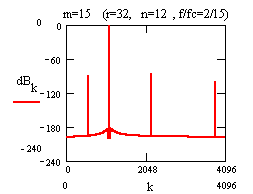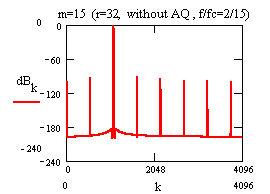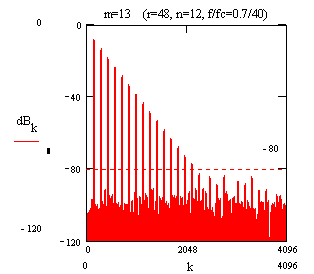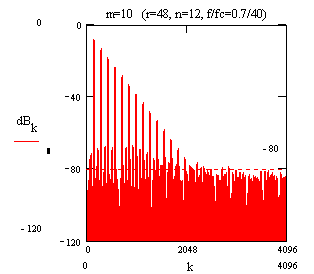 Instrumentation
and Measurement Technology Conference
Instrumentation
and Measurement Technology Conference
IMTC®/2001 - ABSTRACT
Numerical distortion in single-tone DDS
by Zs. Pápay
Keywords: DDS, NCO, amplitude quantization, phase truncation, numerical distortion, spectral purity, simulationIntroduction
Direct Digital Synthesis (DDS) is a technique using digital and mixed/analog processing blocks as a means to generate real-life waveforms and, specifically, a precise, fast frequency and phase tunable output. DDS solutions can be implemented in LSI (large-scale integration), and they play an ever-increasing role in digital waveform generating and modulation.Fig. 1 shows the basic schematic, demonstrating the application of DDS as a single-tone (sine wave) generator. NCO-based DDS is a point(memory location)-skipping technique and runs at a constant update(clock)-rate. There are several applications for DDS that do not convert the digitized samples directly into an analog signal.

Fig. 1 The standard DDS structure
The generic DDS can be viewed as a simple assembly containing only three parts:There is a tradeoff between spectral spurs caused by numerical distortions and the ease of implementation. The two contributions to spectral impurity are amplitude quantization (AQ), being present permanently, and phase truncation (PT). Both errors are periodic (i.e. deterministic) in time, therefore appear as line spectra (spurs) in frequency domain. Knowing the level and location of spurs is a good initial point for the design, selection or length-customizing (FPGA) of an NCO for any specific applications .
(1) fixed rate system clock - the time reference part
(2) NCO - the digital part consists of a phase ACCumulator (register length: r - bit) and a look-up table (LUT, memory address length: m - bit, data length: n - bit). Numerical distortions (algorithmic nonlinearities) due to finite-wordlength are inherent in the system and contribute a major factor to the system complexity.
(3) (Re)construction of analog (sine)wave - the mixed/analog part consist of a digital to analog converter (DAC, bit length: n - bit) and an anti-imaging filter (AIF).
Preliminaries
The spurious components mentioned above are predictable. The spurs depend strongly on the NCO parameters ( r, m, n ) and the numerical frequency ( f/fc = D/2r ). The analytical results (see References, in particular AQ) are rather complicated, not easy to be interpreted and not very useful for practical design. (E.g. spurs vary rather irregularly.)The problem can be solved by interactive computer simulations, by calculating and interpreting data for two distortion mechanisms (AQ and PT) separately, as well as together, depending on the parameters.
Results
Analizing the effect of numerical distortion from another viewpoint, one can regard AQ as overlapped harmonic structure and PT as overlapped modulation structure in frequency domain. In this way, one can easily explain, visualize and interactively examine (with math tools) the parameter dependence of spurs.
On the basis of the previous method, one can answer some challenging questions easily, such as: Where is the quantization noise? [I.e. only loss (no distortion) at f/fc = 1/4, and coincident spurs (massive overlap), close-in spurs (fine offset) or a "sea" of fine spaced spurs are present in the spectrum depending on the value of numerical frequency.] Which effect (AQ or PT) is dominating? What is the right frequency tuning word if you can select the output frequency within a narrow band? What is the relation between periodicity's and spurs? How results depend on the initial phase? ... etc.
An example: AQ and PT interaction
zero-phase
sine, 8K FFT, BH7 (7-term Blackman-Harris) window, with and without AQ


Another example: multisine, and memory length effect:
8K (m=13) vs. 1K (m=10)
cos components
with -5dB level change (and 8K FFT, BH7 window)


Shortcomings of the method: limited length of FFT (or processing time of Megapoint FFT), extra large number of generated frequency. (But one can "zoom" on the interested area.)
Novelties
There is an interaction between AQ and PT.The method can be used for multitone signals. Note: simple superposition is invalid (because of strong nonlinearities).
The method can be extended to dithered DDS.
Simulations of DDS in Mathcad8 woksheets [Online], Available: http://www.hit.bme.hu/people/papay/sci/DDS/simul.htm
(Note: Mathcad8 has a freely downloadable interactive viewer.)
References
The milestone paperJ. Tierney, C. M. Rader, B. Gold, "A digital frequency synthesizer", IEEE Trans. on Audio Electroacoust., vol. AU-19, pp. 48-57, Mar. 1971
A patent
J. A. Webb, "Digital signal generator synthesizer," U.S.
patent No. 3,654,450 - Apr. 1972 [Online], Available:
http://eepatents.com/collection.html#015
Tutorials
Sciteq: "Frequency synthesis & RF subsystems," 1994
Qualcomm: "Synthesizer products data book," 1996
Stanford Telecom: "The DDS handbook," 7th
ed., 1999
Analog Devices: "A technical tutorial on digital synthesis,"
1999
IEE Colloquium on "DDFS", ref. No: 1991/172
V. F. Kroupa (Ed.), "Direct digital frequency synthesizers,"
IEEE
Reprint Press, 1998
B. Goldberg, "Digital frequency synthesis demystified,"LLH
Tech. Pub., 1999
AQ: Amplitude Quantization of sine
wave (lookup-table wordlength effect, deterministic approach)
A. G. Clavier, P. F. Panter, D. D. Grieg, "Distortion
in a pulse count modulation systems," Trans. AIEE, vol. 66, pp.
989-1005, 1947. Essential
substance: "PCM distortion analysis," Electrical
Eng., pp. 1110-1122, Nov. 1947
A. Fujii, K. Azegami, "Quantizing noise for a sine wave
and a set of sine waves," Rev. of the Electrical Commun. Lab., vol.
15, pp. 145-152, Mar./Apr. 1967
M. J. Hawksford, "Unified theory of digital modulation,"
Proc.
IEE, vol. 121, pp. 109-115, Feb. 1974
D. L. Duttweiler, D. G. Messerschmitt, "Analysis of digitally
generated sinusoids with application to A/D and D/A converter testing,"
IEEE
Trans. on Commun., vol. COM-26, pp. 669-675, May 1978
D. R. Morgan, A. Aridgides, "Discrete-time distortion
analysis of quantized sinusoids," IEEE Trans. on Acoust., Speech, Signal
Proc., vol. ASSP-33, pp. 323-326, Feb. 1985
J. H. Blythe, "The spectrum of the quantized sinusoid,"
GEC
J. of Research, vol. 3, no. 4, pp. 229-242, 1985
N. M. Blachman, "The intermodulation and distortion due
to quantization of sinusoids," IEEE Trans. on Acoust., Speech, Signal
Proc., vol. ASSP-33, pp. 1417-1426, Dec. 1985
R. M. Gray, "Quantization noise spectra," IEEE Trans.
on Inform. Theory, vol. 36, pp. 1220-1244, Nov. 1990
R. C. Maher, "On the nature of granulation noise in uniform
quantization systems," J. Audio Eng. Soc., vol. 40, pp.12-19, Jan/Feb.
1992
P. E. K. Chow, "Performance in waveform quantization,"
IEEE
Trans. on Commun., vol. COM-40, pp. 1737-1745, Nov. 1992
E. W. Multanen, Y. C. Jenq, "Harmonic quantization noise
in oversampled analog to digital converters," IMTC'93, pp. 151-153,
1993
D. Bellan, A. Brandolini, A. Gandelli, "Quantizing theory
in electrical and electronic measurements," IEEE Instrum. and Meas.
Tech.
Conf. (IMTC'95), pp. 494-499, 1995. Extended
version: "Quantizing theory - a deterministic
approach," IEEE Trans. on Instrum. and Meas., vol. 48, pp. 18-25,
Feb. 1999
Zs. Pápay, "Comments on 'The Modulo Time
Plot: A Useful Data Acquisition Diagnostic Tool' ", IEEE Trans. on Instrum.
and Meas., Vol. IM-45, No.6, p. 959, 1996 and (error
correction) Vol. IM-46, No. 3, p.
739, 1997
PT: Phase Truncation (lookup-table
address-length effect)
S. Mehrgardt, "Noise spectra of digital sine-generators
using the table-lookup method," IEEE Trans. on Acoust., Speech, Signal
Proc., vol. ASSP-31, pp. 1037-1039, Aug. 1983
J. J. Olsen, P.M. Fishman, "Truncation effect in direct
digital frequency synthesis," Proc. of the 20th Asilomar
Conf. on Signal, Systems and Computers, pp. 186-190, Nov. 1986
Y. C. Jenq, "Digital spectra of non-uniformly sampled
signals with application to digitally synthesized sinusoids," Proc.
Int. Conf. on Acoust., Speech, Signal Proc., vol.2, pp. 689-692, Apr.
1987.
Extended
version:
"Digital spectra of nonuniformly
sampled signals - digital look-up table sinusoidal oscillators," IEEE
Trans. on Instrum. and Meas., vol. 37, pp. 358-362, Sept. 1988
H. T. Nicholas, H. Samueli, "An analysis of the output
spectrum of direct digital frequency synthesizers in the presence of phase-accumulator
truncation," Proc. 41st Annual Frequency Control Symp.,
pp. 495-502, May 1987
H. T. Nicholas, H. Samueli, B. Kim, "The optimization
of direct digital frequency synthesizer performance in the presence of
finite word length effect," Proc. 42nd Annual Frequency Control
Symp., pp. 357-363, May 1988
J. F. Garvey, D. Babitch, "An exact spectral analysis
of a number controlled oscillator based synthesizer," Proc. 44th
Annual Frequency Control Symp., pp. 511-521, May 1990
F. Cercas, M. Tomlinson, A. A. Albuquerque, "Designing
with direct digital frequency synthesizers," RF EXPO EAST '90, pp.625-633,
Nov. 1990
H. P. Benn, "Spurious frequency generation in direct
digital synthesizers," IEE Colloquium on DDFS (Digest No: 1991/172),
pp. 2/1-2/6, Nov. 1991
Zs. Pápay, "DDS signal generator" (1995),
published in Zs. Pápay, "Waveform measurement and synthesis", Muegyetemi
kiadó, Budapest,
1996 (in hungarian)
J. Vankka, "Spur reduction techniques in sine output
direct digital synthesis," Proc. 50st Annual Frequency Control
Symp., pp. 951-959, 1996
J. Vollmer, "Analysis and design of numerically controlled
oscillators based on linear time-variant systems," Proc. of the IEEE-SP
Int. Symp. on Time-Frequency and Time- Scale Analysis, pp. 453-456,
1998
Miscellaneous
"DDS" (Internet links), [Online], Available: http://www.hit.bme.hu/people/papay/sci/DDS/products.htm
Date: 29/9/2000